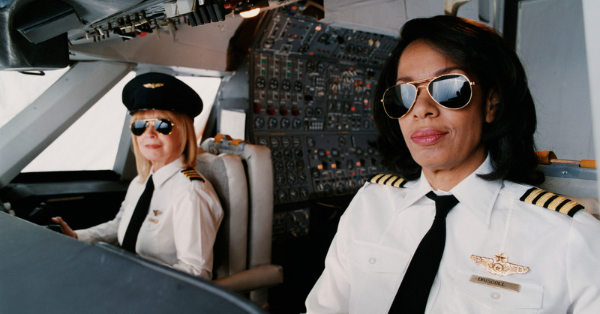High Paying Careers: Airline Pilots
Airline pilots typically begin their careers as commercial pilots. Pilots usually gain flight experience as commercial pilots or in the military to get a job with regional or major airlines.
Minimum time requirements to get a certificate or rating may not be enough to get some jobs. To make up the gap between paying for training and flying for the major airlines, many commercial pilots begin their careers as flight instructors and on-demand charter pilots. These positions typically require less experience than airline jobs require. When pilots have built enough flying hours, they can apply to the airlines.
Licenses, Certifications, and Registrations
Those who are seeking a career as a professional pilot typically get their licenses and ratings in the following order:
- Student pilot certificate
- Private pilot license
- Instrument rating
- Commercial pilot license
- Multi-engine rating
- Airline transport pilot certificate
Education
Airline pilots typically need a bachelor’s degree in any field, including transportation, engineering, or business. They also must have a commercial pilot’s license and an ATP certificate from the FAA. Airline pilots typically start their careers flying as commercial pilots. Commercial pilots usually accrue thousands of hours of flight experience in order to get a job with regional or major airlines.
Commercial pilots must have a commercial pilot’s license, and some employers require or prefer that they have a bachelor’s degree. The most common path to becoming a commercial pilot is to complete flight training with independent FAA-certified flight instructors or at schools that offer flight training. Some flight schools are part of 2- and 4-year colleges and universities.
The FAA certifies hundreds of civilian flight schools, which range from small fixed base operators (FBO) to state universities. Some colleges and universities offer pilot training as part of a 2- or 4-year aviation degree.
Commercial pilot license
To qualify for a commercial pilot license, applicants must meet age and flight-hour requirements. Student pilots use a logbook and keep detailed records of their flight time. The logbook must be endorsed by the flight instructor in order for the student to be able to take the FAA knowledge and practical exams. Specific requirements, including details on the types and quantities of flight experience and knowledge needed, are provided in FARs.
Applicants must pass the appropriate medical exam, meet all of the detailed flight experience and knowledge requirements, and pass a written exam and a practical flight exam in order to become commercially licensed.
The medical exam confirms that the pilot’s vision is correctable to 20/20 and that no physical or mental conditions exist that could impair the pilot’s performance.
Commercial pilots must hold an instrument rating if they want to carry passengers for pay more than 50 miles from the point of origin of their flight, or at night.
Instrument rating
Pilots who earn an instrument rating can fly during periods of low visibility, also known as instrument meteorological conditions, or IMC. They may qualify for this rating by having at least 40 hours of instrument flight experience and 50 hours of cross-country flight time as pilot in command, and by meeting other requirements detailed in the FARs.
Airline transport pilot (ATP) certificate. All pilot crews of a scheduled commercial airliner must have ATP certificates. To earn the ATP certificate, applicants must meet certain requirements, such as for age, hours of flight, and written and practical exams. Airline pilots usually maintain one or more aircraft-type ratings, which allow them to fly aircraft that require specific training, depending on the requirements of their particular airline.
Pilots must pass periodic physical and practical flight examinations to be able to perform the duties granted by their certificate.
Advancement
Commercial pilots may advance to airline pilots after completing a degree, accruing required flight time, and obtaining an ATP license.
Advancement for airline pilots depends on a system of seniority outlined in collective bargaining contracts.
Important Qualities
Communication skills
Pilots must speak clearly when conveying information to air traffic controllers and other crew members. They must also listen carefully for instructions.
Observational skills
Pilots regularly watch over screens, gauges, and dials to make sure that all systems are in working order. They also need to maintain situational awareness by looking for other aircraft or obstacles. Pilots must be able to see clearly, be able to judge the distance between objects, and possess good color vision.
Problem-solving skills
Pilots must be able to identify complex problems and figure out appropriate solutions. When a plane encounters turbulence, for example, pilots assess the weather conditions and request a change in route or altitude from air traffic control.
Quick reaction time
Pilots must respond quickly, and with good judgment, to any impending danger.
Salary
The median annual wage for airline pilots, copilots, and flight engineers was $160,970 in May 2020. The median wage is the wage at which half the workers in an occupation earned more than that amount and half earned less. The lowest 10 percent earned less than $80,920, and the highest 10 percent earned more than $208,000.
The median annual wage for commercial pilots was $93,300 in May 2020. The lowest 10 percent earned less than $47,570, and the highest 10 percent earned more than $200,920.
Outlook
Overall employment of airline and commercial pilots is projected to grow 13 percent from 2020 to 2030, faster than the average for all occupations.
About 14,500 openings for airline and commercial pilots are projected each year, on average, over the decade. Many of those openings are expected to result from the need to replace workers who transfer to different occupations or exit the labor force, such as to retire.
Source: U.S. Bureau of Labor Statistics



Comments are closed.